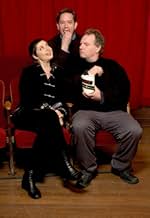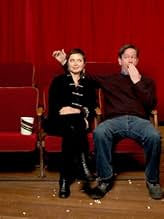CALIFICACIÓN DE IMDb
7.0/10
6.5 k
TU CALIFICACIÓN
Durante la Gran Depresión, una baronesa cervecera en Winnipeg organiza un concurso para encontrar la música más triste del mundo. Músicos de todo el orbe acuden a la ciudad para intentar gan... Leer todoDurante la Gran Depresión, una baronesa cervecera en Winnipeg organiza un concurso para encontrar la música más triste del mundo. Músicos de todo el orbe acuden a la ciudad para intentar ganar el premio de 25.000 dólares.Durante la Gran Depresión, una baronesa cervecera en Winnipeg organiza un concurso para encontrar la música más triste del mundo. Músicos de todo el orbe acuden a la ciudad para intentar ganar el premio de 25.000 dólares.
- Dirección
- Guionistas
- Elenco
- Premios
- 6 premios ganados y 7 nominaciones en total
Nancy Jane Drake
- American Mother
- (as Nancy Drake)
- Dirección
- Guionistas
- Todo el elenco y el equipo
- Producción, taquilla y más en IMDbPro
Opiniones destacadas
Guy Maddin just gets better and better. In this, his latest film, he's outdone himself. The fusion of content and style is so brilliant, clever, and emotional, the film has to rank as one of the best of 2004 even with the year not yet being half over.
Set in 1933, "the depths of the Great Depression", the location is Winnipeg, Canada, home of Lady Port-Huntly (Isabella Rosselini), the astoundingly wealthy beer baroness of Canada, who decides to hold a contest to select the saddest music in the world--for business reasons, of course. Among the entrants are her former lover, Chester Kent (Mark McKinney), his current lover Narcissa (Maria de Medeiros), Chester's estranged brother Roderick (Ross McMillan)--separated from Narcissa, and the men's father, Duncan (Claude Dorge). Duncan represents Canada; Chester, America; and Roderick, Serbia (of all places).
The prize is $25,000, a fortune in those days, so naturally there are entrants from all over the world--among which are Mexico, Siam, and Africa. The music is inspired, but eventually converges on the lilting popular American tune The Song is You, for which there are diverse renditions in the course of the film. The show-stopper is the version by Chester near the end, a big band production that fuses influences, in typical American fashion, from all over the world.
Familial tensions converge with unrequited love, and with the most peculiar prostheses anyone has ever seen--either in real life or on film. Lady Port-Huntly is a double amputee, and he whose reckless mistake resulted in her unfortunate current condition fashions for her a pair of legs that must be seen to be believed.
The entire film is shot using a blue-haze filter, with a faux stereopticon effect that narrows the viewing screen to that resembling what one would see from the early days of film, and with the faintest, subtlest and tiniest of lags in action-speech synchronization that makes this uncannily resonate as a work fusing a 30s setting, a pre-20s style, and a contemporary sensibility that knows how to combine these elements in the first place. This is a truly brilliant--I would even call it genius--approach to filmmaking that noone else in the known world even remotely approaches. Maddin is one of the contemporary masters of cinema and this is the proof.
As soon as this is available on DVD, I will buy it immediately. I suggest you do the same.
Set in 1933, "the depths of the Great Depression", the location is Winnipeg, Canada, home of Lady Port-Huntly (Isabella Rosselini), the astoundingly wealthy beer baroness of Canada, who decides to hold a contest to select the saddest music in the world--for business reasons, of course. Among the entrants are her former lover, Chester Kent (Mark McKinney), his current lover Narcissa (Maria de Medeiros), Chester's estranged brother Roderick (Ross McMillan)--separated from Narcissa, and the men's father, Duncan (Claude Dorge). Duncan represents Canada; Chester, America; and Roderick, Serbia (of all places).
The prize is $25,000, a fortune in those days, so naturally there are entrants from all over the world--among which are Mexico, Siam, and Africa. The music is inspired, but eventually converges on the lilting popular American tune The Song is You, for which there are diverse renditions in the course of the film. The show-stopper is the version by Chester near the end, a big band production that fuses influences, in typical American fashion, from all over the world.
Familial tensions converge with unrequited love, and with the most peculiar prostheses anyone has ever seen--either in real life or on film. Lady Port-Huntly is a double amputee, and he whose reckless mistake resulted in her unfortunate current condition fashions for her a pair of legs that must be seen to be believed.
The entire film is shot using a blue-haze filter, with a faux stereopticon effect that narrows the viewing screen to that resembling what one would see from the early days of film, and with the faintest, subtlest and tiniest of lags in action-speech synchronization that makes this uncannily resonate as a work fusing a 30s setting, a pre-20s style, and a contemporary sensibility that knows how to combine these elements in the first place. This is a truly brilliant--I would even call it genius--approach to filmmaking that noone else in the known world even remotely approaches. Maddin is one of the contemporary masters of cinema and this is the proof.
As soon as this is available on DVD, I will buy it immediately. I suggest you do the same.
What could only be titled as Cinema of the Ridiculous, Maddin's latest masterpiece, about a no-legged beer queen who hosts a Winnipeg-set competition to see which nation has the saddest music in the world, is filled to the gills with wacky ideas, but the reason it's a great film is because of the heartfelt feeling behind it. Maddin's genuine love for the silent cinema that he emulates (and attachment to the pathetic characters he creates) makes it possible for him to sustain a comic tone without it ever becoming mocking.
Maddin manages to balance the grotesque comic caricature of Mark McKinney as the shady mustached businessman who tries to win the competition, and Maria de Medeiros, who gets life advice from her tapeworm, with the pathetic goth character that's McKinney's brother, who's had to deal with the loss of a son, and the glamorous Isabella Rossellini, who's had to deal with the loss of her legs. (I wonder if the fact that Rossellini lost her legs in a car accident caused by her performing fellatio is a nod to the Myth of Murnau.) There's almost a subliminal melodrama taking place with the theme of loss and hilarious depression (during The Depression). It's an exciting movie visually, but unlike the best of the silents that Maddin loves, it's not poetic in that slow, beautiful way -- it's too fast-paced, kinetic, and rough to achieve any sort of traditional beauty -- but it is a feast. The few scenes of gaudy color -- reds, blues, and odd flesh tones -- are as grainy as the black and white. Maddin is truly one of the most imaginative of directors and he has a firm grasp of the medium. In fact, there is at least one scene of slow, beautiful poetry -- a purely silent moment, near the end, that comes alongside the bloody murder of Rossellini's screams. 10/10
Maddin manages to balance the grotesque comic caricature of Mark McKinney as the shady mustached businessman who tries to win the competition, and Maria de Medeiros, who gets life advice from her tapeworm, with the pathetic goth character that's McKinney's brother, who's had to deal with the loss of a son, and the glamorous Isabella Rossellini, who's had to deal with the loss of her legs. (I wonder if the fact that Rossellini lost her legs in a car accident caused by her performing fellatio is a nod to the Myth of Murnau.) There's almost a subliminal melodrama taking place with the theme of loss and hilarious depression (during The Depression). It's an exciting movie visually, but unlike the best of the silents that Maddin loves, it's not poetic in that slow, beautiful way -- it's too fast-paced, kinetic, and rough to achieve any sort of traditional beauty -- but it is a feast. The few scenes of gaudy color -- reds, blues, and odd flesh tones -- are as grainy as the black and white. Maddin is truly one of the most imaginative of directors and he has a firm grasp of the medium. In fact, there is at least one scene of slow, beautiful poetry -- a purely silent moment, near the end, that comes alongside the bloody murder of Rossellini's screams. 10/10
I saw Guy Maddin's film last weekend, not really knowing much about it other than it's premise, which was too absurd to pass up. A double amputee parapalegic beer baroness with glass legs filled with her own beer holding a contest during Prohibition to find the saddest music in the world? Where do people come up with this stuff?
The film is an interesting conglomeration of styles from films before and around the era in which it is set. The 8 mm footage with the stereopticon lens is reminiscent of the earliest films, and the distorted sets created in a studio are reminiscent of the German expressionist films. This is combined with a 30's musical and conversational style, including bits of "Technicolor" thrown in for good measure. I would have to see the film again, but I would like to go back and see it again to determine the link between the scenes which are suddenly shot in color as compared to the grainy black and white images that grace the rest of the film.
Despite the quizzical looks from the three fellow moviegoers who occupied the theatre, I found myself laughing out loud quite a few times at the film's caustic humor. The matches between the music from each country are like something out of a gangland film, with each side advancing toward each other menacingly during their performance. Some of the countries who perform in the competition reflect Maddin's satirical side, including a winning performance from Serbia (of all places) and an entry from the "country" of Africa (as if we in North America don't know any of the individual nations on the continent).
The entwining of satire and comedy continues in the musical performances and the competition's radio commentators. Maybe it's just me, but the funeral dirges from some countries (most notably "Africa" and Scotland) are not really "sad" at all, as they are a bit loud and a bit too upbeat. The greatest offender is the American entry, who turns the competition into a showcase for his Broadway ambitions, eschewing the premise of the competition with the blessing of Lady Port-Huntley, who incidentally is his former-current lover. The idiotic commentators obnoxiously chatter over a loudspeaker even as the musicians are performing, delivering such priceless wisdom as "Siam is known for its dignity, twins, and cats."
The themes of the film revolve around the separation between the rich and the poor (one character enjoys a psychic connection with her tapeworm), American excess, Canadian self-loathing, humanity's relentless desire for the trivial and superficial over the meaningful and spiritual, the global domination of American pop culture, how the mass media controls the world, etc. However, none of these are really fleshed out in the film, but rather touched on briefly then tossed away in favor of the next idea.
Though the film is more style over substance, it is still thoroughly enjoyable for anyone who loves the cinema in all its forms.
The film is an interesting conglomeration of styles from films before and around the era in which it is set. The 8 mm footage with the stereopticon lens is reminiscent of the earliest films, and the distorted sets created in a studio are reminiscent of the German expressionist films. This is combined with a 30's musical and conversational style, including bits of "Technicolor" thrown in for good measure. I would have to see the film again, but I would like to go back and see it again to determine the link between the scenes which are suddenly shot in color as compared to the grainy black and white images that grace the rest of the film.
Despite the quizzical looks from the three fellow moviegoers who occupied the theatre, I found myself laughing out loud quite a few times at the film's caustic humor. The matches between the music from each country are like something out of a gangland film, with each side advancing toward each other menacingly during their performance. Some of the countries who perform in the competition reflect Maddin's satirical side, including a winning performance from Serbia (of all places) and an entry from the "country" of Africa (as if we in North America don't know any of the individual nations on the continent).
The entwining of satire and comedy continues in the musical performances and the competition's radio commentators. Maybe it's just me, but the funeral dirges from some countries (most notably "Africa" and Scotland) are not really "sad" at all, as they are a bit loud and a bit too upbeat. The greatest offender is the American entry, who turns the competition into a showcase for his Broadway ambitions, eschewing the premise of the competition with the blessing of Lady Port-Huntley, who incidentally is his former-current lover. The idiotic commentators obnoxiously chatter over a loudspeaker even as the musicians are performing, delivering such priceless wisdom as "Siam is known for its dignity, twins, and cats."
The themes of the film revolve around the separation between the rich and the poor (one character enjoys a psychic connection with her tapeworm), American excess, Canadian self-loathing, humanity's relentless desire for the trivial and superficial over the meaningful and spiritual, the global domination of American pop culture, how the mass media controls the world, etc. However, none of these are really fleshed out in the film, but rather touched on briefly then tossed away in favor of the next idea.
Though the film is more style over substance, it is still thoroughly enjoyable for anyone who loves the cinema in all its forms.
And I thought `Dogville' was stylized. Canadian writer/director Guy Maddin ("Dracula: Pages from a Virgin's Diary,' "Archangel') has created a film like no other this year except possibly `Triplet's of Belleville.' `The Saddest Music in the World' is a `musical' set in Winnipeg in 1933, where Lady Port-Huntly (Isabella Rossellini) is holding a contest to award $25,000 to the saddest music performer. In `Depression Era dollars,' no less.
Winnipeg has been declared by the London Times `the world capital of sorrow' for the fourth year in a row. What happens in the film can be categorized as surrealism of the sort that marries the Melies brothers in their `Trip-to-the-Moon' wackiest to `The Twilight Zone' in Rod Serling's most hilarious (and that's pretty unusual) moments. Shot in distressed mode with 8 mm blown up to be grainy and silent movieish, `Saddest' has blue-grays and silvers and occasional bursts of washed-out color that give it an otherworldly cast meant to satirize the old movies and create a new look built on nostalgia and freedom from convention that some call expressionism.
Some of the bizarre acts vying for the prize are Fyodor (David Fox), a veteran of World War I representing Canada, who plays a deathlike version of ''The Red Maple Leaves'' on an upright piano he has turned over, and Indian singers in Eskimo costumes, who dance to ''California Here I Come'' with sitars and banjos commemorating a 19th-century kayaking accident. All the time an iris lens blurs the edges of the film to recreate the ancient look of film found in a vault after 50 years.
That Lady Port-Huntly needs artificial legs is not as bizarre as the back story of how she came to need them, and that the new glass legs have local beer coursing through them is just another creative and absurdist touch. With a resemblance to the robot in `Metropolis,' she is an amalgam of strange and prophetic moments in film and culture. I know I'm not making much sense here-Trust me that this film is bizarre enough to satisfy the geekiest cultist in our audience. For the rest of us, just trying to appreciate all the signposts Maddin constructs to further his absurd and funny vision is exhausting. Wordsworth's thoughts apply because we at least hear `the still, sad music of humanity.'
Winnipeg has been declared by the London Times `the world capital of sorrow' for the fourth year in a row. What happens in the film can be categorized as surrealism of the sort that marries the Melies brothers in their `Trip-to-the-Moon' wackiest to `The Twilight Zone' in Rod Serling's most hilarious (and that's pretty unusual) moments. Shot in distressed mode with 8 mm blown up to be grainy and silent movieish, `Saddest' has blue-grays and silvers and occasional bursts of washed-out color that give it an otherworldly cast meant to satirize the old movies and create a new look built on nostalgia and freedom from convention that some call expressionism.
Some of the bizarre acts vying for the prize are Fyodor (David Fox), a veteran of World War I representing Canada, who plays a deathlike version of ''The Red Maple Leaves'' on an upright piano he has turned over, and Indian singers in Eskimo costumes, who dance to ''California Here I Come'' with sitars and banjos commemorating a 19th-century kayaking accident. All the time an iris lens blurs the edges of the film to recreate the ancient look of film found in a vault after 50 years.
That Lady Port-Huntly needs artificial legs is not as bizarre as the back story of how she came to need them, and that the new glass legs have local beer coursing through them is just another creative and absurdist touch. With a resemblance to the robot in `Metropolis,' she is an amalgam of strange and prophetic moments in film and culture. I know I'm not making much sense here-Trust me that this film is bizarre enough to satisfy the geekiest cultist in our audience. For the rest of us, just trying to appreciate all the signposts Maddin constructs to further his absurd and funny vision is exhausting. Wordsworth's thoughts apply because we at least hear `the still, sad music of humanity.'
I had always been told that director Guy Maddin did nothing conventionally, and so I approached The Saddest Music in the World with anticipation and hesitation. I am a great fan of Isabella Rossellini and Maria de Medeiros, both of whom do well in this picture. Maddin delivers a picture that is quite beautiful visually; all in black and white, and edited in such a way as to recall something resurrected from the 1930s. There are a few occasions when colour is allowed in, and those moments dazzle. One of the most striking images I have seen all year is Isabella Rossellini posing in Technicolour standing on glass legs filled with beer. It's something that has to be seen to be believed. However, once you get past the visuals, the film is rather empty and lacks heart. I do recommend it, though, because everyone should see something new and different (and for Isabella and Maria).
¿Sabías que…?
- TriviaSome actors are given an "additional camera" credit, as they shot footage on handheld Super8 cameras.
- Citas
Lady Port-Huntley: If you are sad and like beer, I'm your lady.
- Bandas sonorasThe Song is You
Music by Jerome Kern
Lyrics by Oscar Hammerstein II
Used by permission of Universal - Polygram International Publishing, Inc.
Selecciones populares
Inicia sesión para calificar y agrega a la lista de videos para obtener recomendaciones personalizadas
- How long is The Saddest Music in the World?Con tecnología de Alexa
Detalles
- Fecha de lanzamiento
- País de origen
- Idiomas
- También se conoce como
- La canción más triste del mundo
- Locaciones de filmación
- Productoras
- Ver más créditos de la compañía en IMDbPro
Taquilla
- Presupuesto
- CAD 3,500,000 (estimado)
- Total en EE. UU. y Canadá
- USD 699,225
- Fin de semana de estreno en EE. UU. y Canadá
- USD 37,743
- 2 may 2004
- Total a nivel mundial
- USD 854,994
- Tiempo de ejecución1 hora 40 minutos
- Color
- Mezcla de sonido
- Relación de aspecto
- 1.85 : 1
Contribuir a esta página
Sugiere una edición o agrega el contenido que falta

Principales brechas de datos
By what name was The Saddest Music in the World (2003) officially released in India in English?
Responda































